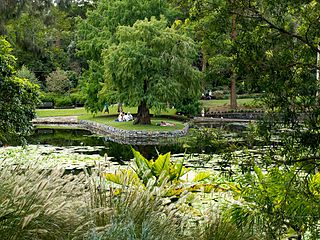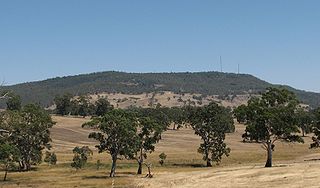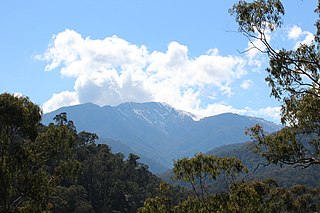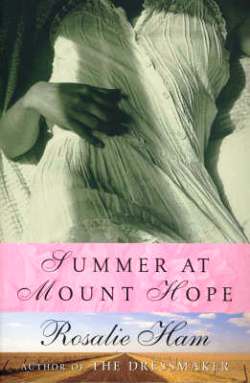
The Mount Buffalo National Park is a national park in the alpine region of Victoria, Australia. The 31,000-hectare (77,000-acre) national park is located approximately 350 kilometres (220 mi) northeast of Melbourne in the Australian Alps. Within the national park is Mount Buffalo, a moderately high mountain plateau, with an elevation of 1,723 metres (5,653 ft) above sea level.

Mount Walsh is a national park in Queensland, Australia, 230 kilometres (140 mi) northwest of Brisbane.

Mount Baw Baw is a mountain summit on the Baw-Baw Plateau of the Great Dividing Range, located in Victoria, Australia. The name is from the Woiwurrung language spoken by Eastern Kulin people. It is of uncertain meaning, but possibly signifies, echo, or ghost.

Mount Lofty is the highest point in the southern Mount Lofty Ranges. It is located about 15 km (9.3 mi) east of the Adelaide city centre, within the Cleland National Park in the Adelaide Hills area of South Australia.

Mount Coot-tha is a mountain and a suburb of the City of Brisbane, Queensland, Australia. Visible from much of the city, Mount Coot-tha is a popular bushland tourist destination including the Mount Coot-tha Lookout, Brisbane Botanic Gardens and Sir Thomas Brisbane Planetarium, as well as a mountain drive, bike trails, parks including a waterfall, and television and radio towers. In the 2021 census, Mount Coot-tha had a population of 0 people.

The Prince Charles Mountains are a major group of mountains in Mac. Robertson Land in Antarctica, including the Athos Range, the Porthos Range, and the Aramis Range. The highest peak is Mount Menzies, with a height of 3,228 m (10,591 ft). Other prominent peaks are Mount Izabelle and Mount Stinear. These mountains, together with other scattered peaks, form an arc about 420 km (260 mi) long, extending from the vicinity of Mount Starlight in the north to Goodspeed Nunataks in the south.

Mount Alexander is a mountain located approximately 125 km north-west of Melbourne, near the town of Harcourt. It rises 350 metres above the surrounding area to a level of 744 metres above sea level. Being a prominent local landmark, the mountain has its name associated with the surrounding district once known as the Mount Alexander goldfields, and presently defined as the Shire of Mount Alexander, centred on Castlemaine. Most of the mountain is included within the boundaries of the Mount Alexander Regional Park managed by Parks Victoria. The Djadjawurrung name for the mountain is Lanjanuc.

Mount Buller is a mountain in the Victorian Alps of the Great Dividing Range, located in the Australian state of Victoria. It has an elevation of 1,805 metres (5,922 ft) AHD.

Mount Macedon is a dormant volcano that is part of the Macedon Ranges of the Great Dividing Range, located in the Central Highlands region of Victoria, Australia. The mountain has an elevation of 1,001 metres (3,284 ft) with a prominence of 643 metres (2,110 ft) and is located approximately 65 kilometres (40 mi) northwest of Melbourne.

West Mount Barren is part of the Fitzgerald River National Park located between Bremer Bay and Hopetoun on the south coast of Western Australia the coordinates of the summit of West Mount Barren are 34°12′59″S119°25′58″E.
Mount Disappointment is an 800-metre (2,600 ft) mountain located on the southern end of the Great Dividing Range, 9.5 kilometres (5.9 mi) north of Whittlesea and 60 kilometres (37 mi) north of Melbourne, the state capital of Victoria, Australia. It was named by explorers Hume and Hovell in 1824, and is now a popular hiking spot.

Mount Hay, a mountain that is part of the Mt Hay Range of the Blue Mountains Range which is a spur off the Great Dividing Range, is located in the Blue Mountains National Park, New South Wales, Australia. It is located approximately 100 kilometres (62 mi) west of Sydney and 10 kilometres (6.2 mi) north of the nearest town, Wentworth Falls. Mount Hay is approximately 944 metres (3,097 ft) AMSL and is one of several basalt caps located within the UNESCO World Heritage Greater Blue Mountains Area.

Mount Wycheproof is a location in the small town of Wycheproof, Victoria, Australia, which stands at 42 metres (138 ft) above the surrounding terrain and 147 metres above sea level. The township of Wycheproof is located on the hillside, and a unique geological substance known as Wycheproofite is exclusive to the local area.

Pine Mountain is a gigantic monolith, said to be 1.5 times bigger than Uluru, situated in the Burrowa-Pine Mountain National Park in Australia.
Mount Selma is a mountain located to the north-east of Aberfeldy in Victoria, Australia. Its peak is 1463 metres above sea level. The headwaters of the Aberfeldy River rise on its southerly slopes.

Mount Franklin is an extinct volcano about 10 km north of Daylesford and 4.6 km south east of Franklinford in Victoria, Australia. A road spirals round the outside slopes covered with pine trees, into a flat 50 acre caldera, and onto the rim which hosts a fire lookout, parking area and picnic ground.

Mt. Baw Baw Alpine Resort is a small Australian downhill ski resort located approximately 120 kilometres (75 mi) east of Melbourne and 50 kilometres (31 mi) north of the Latrobe Valley in Victoria. The Alpine Resort is an unincorporated area which is surrounded by the Baw Baw National Park and the Australian Alps Walking Track passes nearby. The summit of Mount Baw Baw (1567m) falls within the boundaries of the resort and is accessible by lift or walking trail. The resort is also a base for cross-country skiing on the Baw-Baw Plateau.
Mount Teneriffe in central Victoria, Australia, is a distinctive granite formation, 444 m (1,457 ft) above sea level. It takes its name from the island of Tenerife in Spain.

Summer at Mount Hope is a black comedy romantic novel, written by Australian author Rosalie Ham. Like Ham's debut novel The Dressmaker, it is also set in small rural community but in 1890s Australia. The novel centred on protagonist Phoeba Crupp and her struggle with money and male companionship.

















